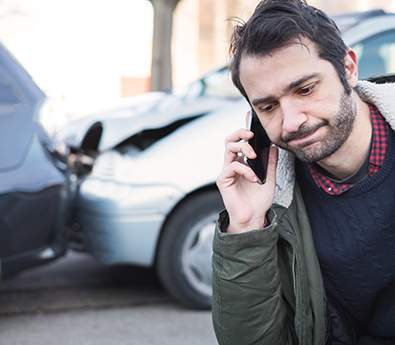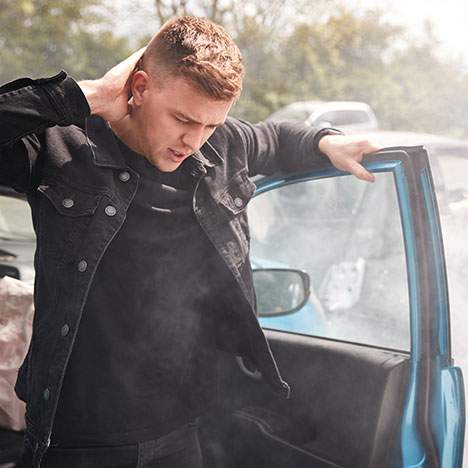Taking Action: Claiming Against an Uninsured Driver
Getting into a car accident is troubling enough, but finding that the at-fault driver is uninsured can make the situation even more stressful. If you’re looking for quick steps to take when claiming against an uninsured driver, here they are:
- Call the police and file a report.
- Gather contact information from the other driver and any witnesses.
- Document the scene and damage with photos.
- Contact your insurance company to file an uninsured motorist claim.
- Consult a personal injury attorney for legal advice.
When it comes to having a car insurance policy, most of us consider it a no-brainer. Not only is it legally required in most states, but it also offers essential financial protection. However, despite these regulations, about 1 in 8 drivers still hit the road without any insurance. That leaves responsible drivers like you vulnerable to accidents with uninsured motorists, leading to significant financial and emotional burdens.
Imagine waiting at a traffic light, only to be rear-ended by another driver who then admits they don’t have insurance. Your car is damaged, you have medical bills stacking up, and you’re left wondering how to cover these unexpected costs. This scenario highlights the importance of understanding uninsured motorist coverage and knowing the steps to take immediately after such an accident.
Avrek Law Firm specializes in helping individuals steer the complexities of uninsured motorist claims. We understand the strain it puts on your financial and emotional well-being. Our expertise ensures that you get the compensation you deserve, so you can focus on recovery rather than worrying about the legal intricacies.

Understanding Uninsured Motorist Coverage
Types of Uninsured Motorist Coverage
Uninsured motorist coverage (UM) is a crucial part of your auto insurance policy that protects you if you’re in an accident caused by a driver who doesn’t have insurance. There are two main types of UM coverage:
- Uninsured Motorist Bodily Injury (UMBI): This covers medical bills, pain and suffering, and lost wages for you and your passengers.
- Uninsured Motorist Property Damage (UMPD): This pays for damage to your vehicle and other property.
In some cases, you might also encounter underinsured motorist coverage (UIM), which comes into play when the at-fault driver has insurance, but their limits are too low to cover your expenses.
How Uninsured Motorist Coverage Works
When you’re involved in an accident with an uninsured driver, your UM coverage kicks in to cover your damages. Here’s a step-by-step look at how the process works:
1. Filing a Report
First and foremost, call the police and file a report. This documentation is crucial for your insurance claim. The police report will include essential details like the date, time, and location of the accident, as well as statements from both drivers and any witnesses.

2. Contacting Your Insurance Company
Next, notify your insurance company about the accident. Provide them with all the details, including the police report number, the other driver’s contact information, and any witness statements.
3. Documentation
Gather as much documentation as possible. This includes:
- Photos of the accident scene and vehicle damage
- Medical records and bills
- Repair estimates for your vehicle
- Statements from witnesses

4. The Claim Process
Once your insurance company has all the necessary information, they’ll begin the claim process. This involves:
- Reviewing the police report and your documentation
- Assessing the extent of your damages
- Determining the liability of the uninsured driver
Your insurance company may also engage in subrogation, where they attempt to recover costs from the uninsured driver. However, this can be challenging if the driver lacks financial assets.
5. Compensation
The compensation you receive will depend on your policy limits. Typical UM coverage can include:
- Medical Expenses: Covers hospital stays, surgeries, medications, and rehabilitation.
- Lost Income: Compensates for wages lost due to your inability to work.
- Pain and Suffering: Addresses the emotional and physical toll of the accident.
- Property Damage: Pays for repairs or replacement of your vehicle.
Real-World Example
Consider Jane, who was hit by an uninsured driver while driving home from work. She suffered a fractured arm and her car was significantly damaged. By filing a UM claim, Jane was able to cover her medical bills, compensate for her lost wages, and repair her vehicle without bearing the financial burden herself.

Final Thoughts
Understanding uninsured motorist coverage can make a world of difference when you’re dealing with the aftermath of an accident with an uninsured driver. Proper documentation, timely reporting, and knowing your policy limits are key to ensuring you get the compensation you deserve.
Next, we’ll dig into Steps to Take After an Accident with an Uninsured Driver to help you steer the immediate aftermath of such incidents.
Steps to Take After an Accident with an Uninsured Driver
Filing an Uninsured Motorist Claim
If you’re involved in an accident with an uninsured driver, following the right steps can make a big difference in your claim process. Here’s what you need to do:
Immediate Steps
Ensure Safety: First, make sure everyone is safe. Move to a safe location if possible and check for injuries. Call 911 if anyone needs medical attention.
Notify the Police: Always call the police to report the accident. A police report is essential for your claim. It will document the details of the accident, including the uninsured driver’s information.
Exchange Information: Gather information from the other driver, even if they don’t have insurance. This includes their name, contact details, and driver’s license number. Also, collect contact information from any witnesses.
Document the Scene: Take photos and videos of the accident scene, vehicle damage, and any visible injuries. This visual evidence can be crucial for your claim.
Filing Process
Report to Your Insurance Company: Contact your insurance company as soon as possible. Provide them with the police report number, photos, and any witness statements. Use the MyAmFam app for a smooth and convenient claims process if you’re with American Family Insurance.
Submit Documentation: Gather all necessary documents, such as medical bills, repair estimates, and any other expenses related to the accident. Submit these to your insurer.
Investigation: Your insurance company will investigate the claim. They may review the police report, assess the damage, and verify the uninsured status of the other driver.
Arbitration: If there’s a dispute about the claim, you might need to go through arbitration. This is where an arbitrator reviews the case and makes a binding decision.
Filing a Personal Injury Lawsuit
If your insurance coverage is insufficient or you want to seek additional compensation, you might consider filing a personal injury lawsuit against the uninsured driver.
Legal Action
Consult a Personal Injury Attorney: Contact an experienced attorney, like those at Avrek Law Firm, to discuss your case. They can help you understand your legal options and the best course of action.
Asset Investigation: Your lawyer will investigate the uninsured driver’s assets. If they have valuable assets, your lawyer can help you file a lien. This freezes their assets during the lawsuit, ensuring they can’t sell them before a judgment.
Filing the Lawsuit: Your attorney will file the lawsuit on your behalf. This legal action can help you recover compensation for medical bills, lost wages, pain and suffering, and property damage.
Payment Plan: If the uninsured driver doesn’t have enough assets to pay a lump sum, the court can set up a payment plan. This ensures you receive compensation over time.
Subrogation
If you have uninsured motorist coverage, your insurance company might pursue subrogation. This means they will try to recover the costs from the uninsured driver. However, this can be challenging if the driver has limited financial resources.
Real-World Example
Imagine being hit by an uninsured driver while on your way to work. Your car is totaled, and you sustain several injuries. By following the steps above, you can file a successful uninsured motorist claim and also pursue a personal injury lawsuit. This can help cover your medical bills, lost wages, and repair costs without bearing the financial burden yourself.
Next, we’ll explore Claiming Against an Uninsured Driver: Legal Options to help you understand your rights and the legal avenues available.
Claiming Against an Uninsured Driver: Legal Options
When you’re in an accident with an uninsured driver, you have several legal options to consider. Here’s a breakdown of what you can do:
When to File a Lawsuit
Filing a lawsuit against an uninsured driver is a serious decision. It’s essential to assess whether the driver has enough assets to make it worthwhile. If they don’t, you might win the case but still not get any money.
Consider these factors before filing a lawsuit:
Uninsured Driver Assets: Your attorney will investigate the driver’s financial situation. If they have valuable assets, you can file a lien to freeze these assets during the lawsuit.
Financial Recovery: If the driver has no assets, the court might set up a payment plan. This way, you receive compensation over time.
Legal Strategy: Discuss with your attorney the best approach for your case. They can help you understand the potential outcomes and whether filing a lawsuit is the best option.
Working with a Personal Injury Attorney
Navigating the legal process can be complex, so it’s crucial to work with a skilled personal injury attorney. Here’s how they can help:
Legal Consultation: Schedule a consultation with an attorney to discuss your case. They will review your situation and advise you on the best course of action.
Case Strategy: Your attorney will develop a strategy custom to your case. This includes investigating the uninsured driver’s assets and determining the most effective legal actions.
Subrogation: If you have uninsured motorist coverage, your insurance company might pursue subrogation. This means they will try to recover costs from the uninsured driver. Your attorney can assist in this process.
Arbitration: If there’s a dispute about your claim, you might need to go through arbitration. An arbitrator will review the case and make a binding decision. Your attorney will represent you during this process to ensure the best possible outcome.
Filing a Personal Injury Lawsuit: If your insurance coverage is insufficient, your attorney can help you file a lawsuit. This legal action can help you recover compensation for medical bills, lost wages, pain and suffering, and property damage.
Real-World Example
Consider Sarah, who was hit by an uninsured driver while commuting. Her car was severely damaged, and she needed medical treatment. By working with a personal injury attorney, Sarah was able to file an uninsured motorist claim and pursue a personal injury lawsuit. Her attorney helped her recover the costs of medical bills, lost wages, and car repairs.
Next, we’ll explore the Frequently Asked Questions about Claiming Against an Uninsured Driver to help you understand your rights and the legal avenues available.
Frequently Asked Questions about Claiming Against an Uninsured Driver
What happens if someone hits you and you don’t have insurance?
If someone hits you and you don’t have insurance, you could face several penalties and challenges. First, you might be subject to fines and penalties for driving without insurance, depending on your state’s laws.
Here’s what you might face:
- Fines and Penalties: Many states impose fines for driving without insurance. For example, California can suspend your vehicle registration if you’re caught without insurance.
- Out-of-Pocket Costs: Without insurance, you’ll be responsible for all medical expenses and car repairs.
- Legal Trouble: If the accident is your fault, the other party can sue you for damages, leading to potential wage garnishment or liens on your property.
Can you sue an uninsured driver?
Yes, you can sue an uninsured driver, but it’s important to consider whether it’s worth the effort.
Key considerations include:
- Legal Rights: You have the right to sue the at-fault driver in a personal injury lawsuit to recover damages for medical bills, pain and suffering, and property damage.
- Small Claims Court: For smaller amounts, you might consider filing in small claims court. This is quicker and less expensive than a full lawsuit.
- Asset Recovery: If the uninsured driver has assets, you can potentially recover your damages. However, if they lack assets, winning the lawsuit might not result in actual compensation.
What does uninsured motorist cover?
Uninsured motorist (UM) coverage is designed to protect you in accidents involving drivers who don’t have insurance.
UM coverage typically includes:
- Bodily Injury: This covers medical expenses, lost wages, and pain and suffering for you and your passengers.
- Property Damage: This pays for repairs or replacement of your vehicle and other property damaged in the accident.
Example: If you’re hit by an uninsured driver and suffer whiplash, your UM coverage would help cover your medical bills and any lost wages due to missed work.
Understanding these aspects can help you steer the complexities of accidents involving uninsured drivers. If you need further assistance, consulting a personal injury attorney can provide you with custom legal advice and support.
Conclusion
Navigating the aftermath of a car accident with an uninsured driver can be a daunting task. From dealing with medical bills to vehicle repairs and legal complexities, the journey to compensation can feel overwhelming. However, understanding your legal options and taking prompt action can significantly impact the outcome of your case.
Legal Action is Crucial
Taking legal action is essential to protect your rights and secure the compensation you deserve. Whether you’re filing an uninsured motorist claim with your own insurance company or pursuing a personal injury lawsuit against the at-fault driver, the legal process can help you recover damages for medical expenses, lost wages, pain and suffering, and property damage.
Avrek Law Firm: Your Ally in Legal Battles
At Avrek Law Firm, we specialize in personal injury cases, including those involving uninsured drivers. Our experienced attorneys understand the intricacies of these cases and are dedicated to fighting for fair compensation for accident victims.
Free Consultation and Contingency Basis
We offer a free consultation to discuss your case and outline your legal options. What’s more, we work on a contingency basis, meaning you pay nothing unless we win your case. This approach ensures that you can pursue justice without financial stress.
If you’ve been involved in an accident with an uninsured driver, don’t steer this challenging time alone. Contact Avrek Law Firm today to schedule your free consultation and take the first step toward securing the compensation you deserve.
Taking these steps can make a significant difference in your recovery process. By understanding your options and seeking the right legal support, you can focus on healing while we handle the complexities of your case.
